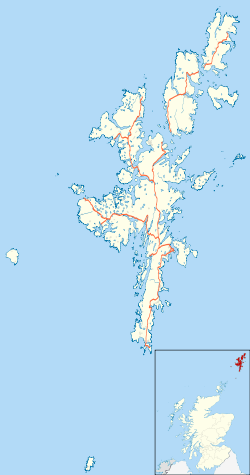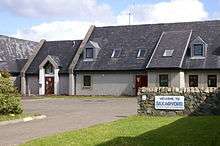RAF Saxa Vord
| RRS Saxa Vord | |
|---|---|
| Unst, Shetland Islands in Scotland | |
 Radar dome at RRS Saxa Vord. | |
 | |
 RRS Saxa Vord Shown within Shetland | |
| Coordinates | 60°49′39″N 0°50′28″W / 60.82750°N 0.84111°WCoordinates: 60°49′39″N 0°50′28″W / 60.82750°N 0.84111°W |
| Type | Remote Radio Site |
| Site information | |
| Owner | Ministry of Defence |
| Operator | Royal Air Force |
| Controlled by | No. 1 Group (Air Combat) |
| Site history | |
| Built | 1957 |
| In use | 2006-Present |
| Garrison information | |
| Occupants | Radar Flight (North) |
Remote Radar Head Saxa Vord or RRH Saxa Vord, is a Royal Air Force radar station located on the island of Unst, the most northern of the Shetland Islands in Scotland. As of February 2018 it is currently in the process of reactivation,[1] after closure in 2006.[2] The station's motto "Praemoneo de Periculis" (Premonition of Peril) reflects its role.
History
Early years
The island of Unst has played an important part in the defence of the UK since the outbreak of the Second World War. By 1945, there were two radar sites in existence — one on Saxa Vord hill, and the other at Skaw on the east coast. This latter is the older, being built in 1941, and was part of the Chain Home radar network as part of the defences of the Sullom Voe flying boat base. Skaw closed in 1947. Ten years later, 91 Signals Unit was formed, and became fully operational on 5 October 1957.
Cold War era
The AMES Type 80 radar had much greater range than earlier designs, allowing Saxa Vord to provide radar coverage over a large expanse of the North Sea. As part of the overall ROTOR system, installation of a Type 80 started in 1955, but was blown 50 yards (46 m) off its mountings by winds gusting to 177 miles per hour (285 km/h) in January 1956. A newly designed Mark II design replaced the original that year.[3] No 91 Signals Unit officially formed up at Saxa Vord on 27 September 1957, was declared operational on 5 October 1957 and in 1960 was visited by Queen Elizabeth II.
In the early days, the site was shared with the Royal Navy which worked in the Admiralty building. In the following years, RAF Saxa Vord was a vital part of Britain's air defence during the Cold War. During this period, there was a game of cat-and-mouse, originally with English Electric Lightning, then F-4 Phantom and finally Tornado F3 aircraft, intercepting Soviet TU-95 probing flights and escorting them out of UK airspace. RAF Saxa Vord consisted of three sites: the domestic site, the technical site and the married quarters called Setters Hill Estate (SHE).
The technical site was originally home to a Type 80 search radar, a Type 14 standby reporting radar and a Type 13 height finder. The Type 80 was unfortunately lost when it was blown away in 1959 and rebuilt with the radome being built in 1962. In 1979, there was a 649 search radar (Type 96) and height finder HF200, and these were planned to be replaced by the Type 93 in the mid-90s as part of the new IUKADGE system.
When the Type 93 became obsolete a radical new method was tried. RAF Saxa Vord was a part of the Sector 1 of the UK Air Defence Region (the RAF covering most of NATO Early Warning Area 12, some 750,000 square miles). Sector 1 was the airspace north of the 55th parallel north. Being a Control and Reporting Post(CRP)/ Reporting Post (RP), it passed its radar picture and information (along with RAF Benbecula) to the Sector Operations Centre (SOC /CRC) RAF Buchan, which also received information from the Danish site on the Faroe Islands. It was also home to Shetland Radar, which provided a radar service to civilian helicopters transiting from Aberdeen/Sumburgh and Unst out to the oil fields.
In 1984 the station was renamed from No. 91 Signals Unit to Royal Air Force Saxa Vord. The signals unit badge was adopted by the station and it continued with the motto of Praemoneo de periculis (Latin for I give advanced warning about danger).[4][5]
Downgrading to Remote Radar Head
From around 2000 until 2 April 2004, the station operated as Remote Radar Head (RRH) Saxa Vord, operated from parent station RAF Buchan. On 2 April 2004, RAF Saxa Vord was upgraded from a Remote Radar Head to a full manned station, taking over control of the radar defences in the area. RAF Buchan was intended be downgraded to a Remote Radar Head.
Closure
RAF Saxa Vord closed in April 2006.[6]
April 2007 saw the purchase of RAF Saxa Vord's Domestic Site, plus the road up to the Mid Site, by Military Asset Management (MAM).

Saxa Vord is being redeveloped into a new tourism venture: Britain's first "residential natural and cultural heritage activity centre", based on the island of Unst.
The first phase is complete and offers 20 self-catering holiday houses and a 16-bedroom bunkhouse, together with a restaurant and bar. 2008 will see the launch of a new hotel, leisure facilities and a guided walks/evening talks programme.
RAF Saxa Vord is further north than Leningrad (now Saint Petersburg), and on the same latitude as Anchorage, Alaska. The station was named after Saxa Vord, which is the highest hill on Unst at 935 ft (285 m).[7] It holds the unofficial British record for wind speed, which in 1992 was recorded at 197 mph (317 km/h) — just before the measuring equipment blew away.
Reactivation of remote radar head
In September 2017, the Ministry of Defence confirmed that £10 million would be invested in Saxa Vord to reactivate the site as a remote radar head. The move is in order to provide improved coverage of the airspace to the north of the UK, in response to increased Russian military activity.[8][9] Work commenced in October 2017 to install a new radar system, involving a Lockheed Martin AN/TPS-77 L-band radar being relocated to Saxa Vord from RRH Staxton Wold in North Yorkshire.[10]
During January 2018, Chief of the Air Staff, Air Chief Marshal Sir Stephen Hillier visited the site to inspect progress and the new radar reached initial operational capability. It is expected to reach full operational capability by the end of 2018.[9][11]
Once operational, no additional personnel would be permanently based at Saxa Vord, however periodical visits by RAF personnel and contractors would take place for maintenance purposes.[8]
See also
References
- ↑ "UK RAF RADAR COVERAGE TO BE ENHANCED". Mönch Verlagsgesellschaft mbH. 21 September 2017. Retrieved 5 February 2018.
- ↑ Newton, Grace (17 September 2017). "RAF re-open radar base on Britain's most northerly island". The Yorkshire Post. Retrieved 8 March 2018.
- ↑ McCamley, Nick. Cold War Secret Nuclear Bunkers. p. 87.
- ↑ Pine, L.G. (1983). A dictionary of mottoes (1 ed.). London: Routledge & Kegan Paul. p. 178. ISBN 0-7100-9339-X.
- ↑ "No.91 Signals Unit | RAF Heraldry Trust". www.rafht.co.uk. Retrieved 8 March 2018.
- ↑ Harper, Tom (17 September 2017). "RAF reopens Shetland radar site Saxa Vord to sweep for Russia threat". The Sunday Times. Retrieved 8 March 2018. (Subscription required (help)).
- ↑ MacLeod, Angus (22 July 2005). "Island faces bleak future as RAF abandons base". The Times. p. 25. ISSN 0140-0460.
- 1 2 Cope, Chris (16 September 2017). "Unst radar base work to begin in October". Shetland News. Shetland News Online Ltd. Retrieved 18 September 2017.
- 1 2 "New Shetland radar to better protect UK northern airspace". Royal Air Force. 26 January 2018. Retrieved 28 February 2018.
- ↑ Withington, Thomas (21 September 2017). "UK RAF radar coverage to be enhanced". Mönch Publishing Group. Retrieved 28 February 2018.
- ↑ Bebb, Guto (27 February 2018). "RAF Saxa Vord:Written question - 129067". UK Parliament. Retrieved 28 February 2018.